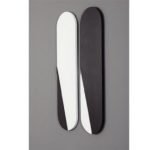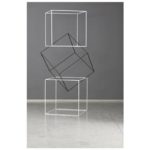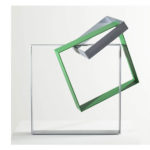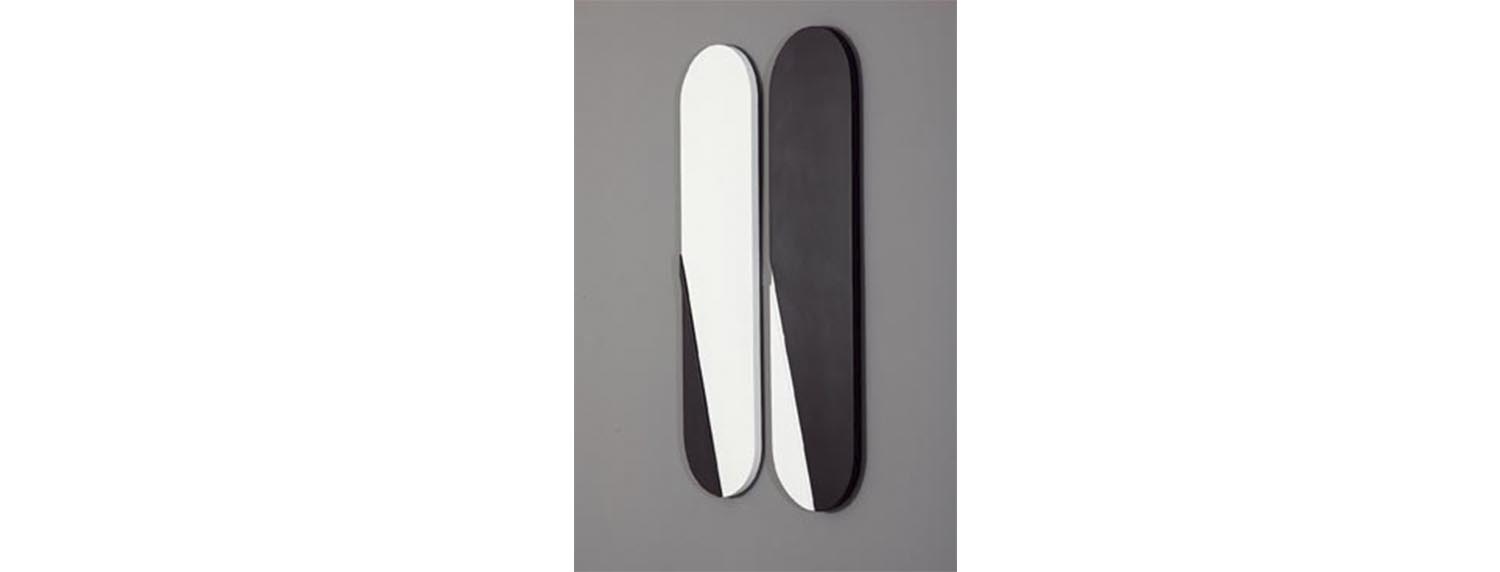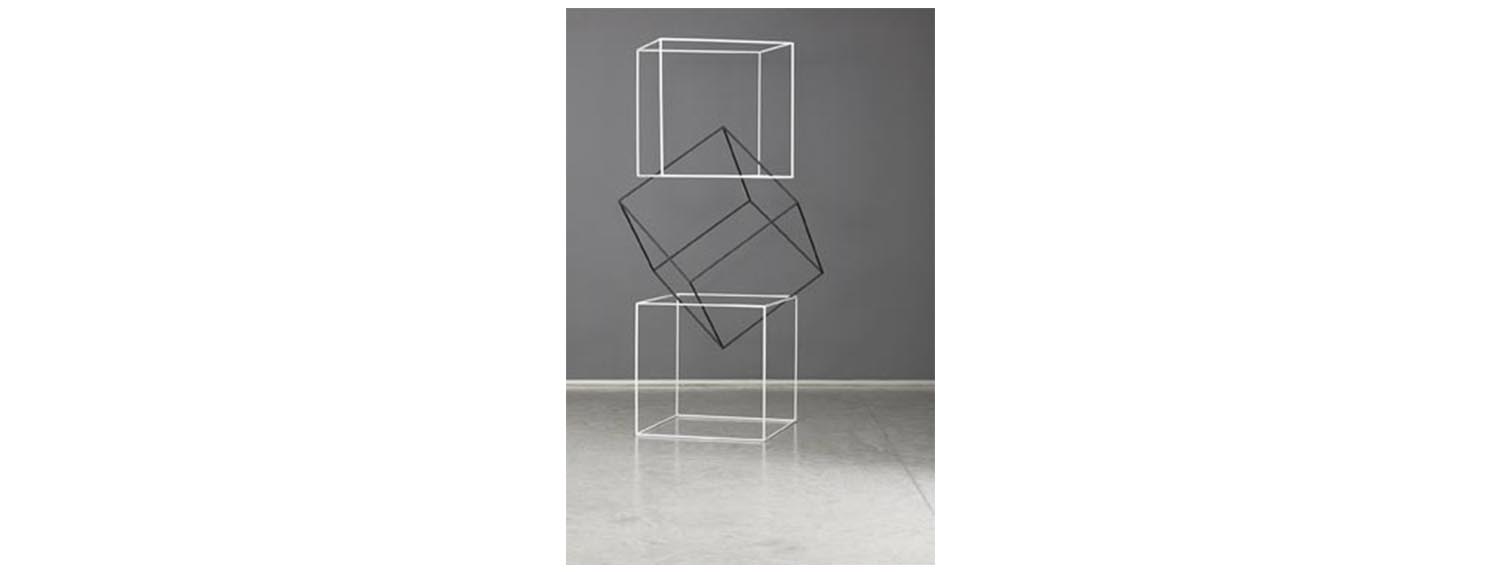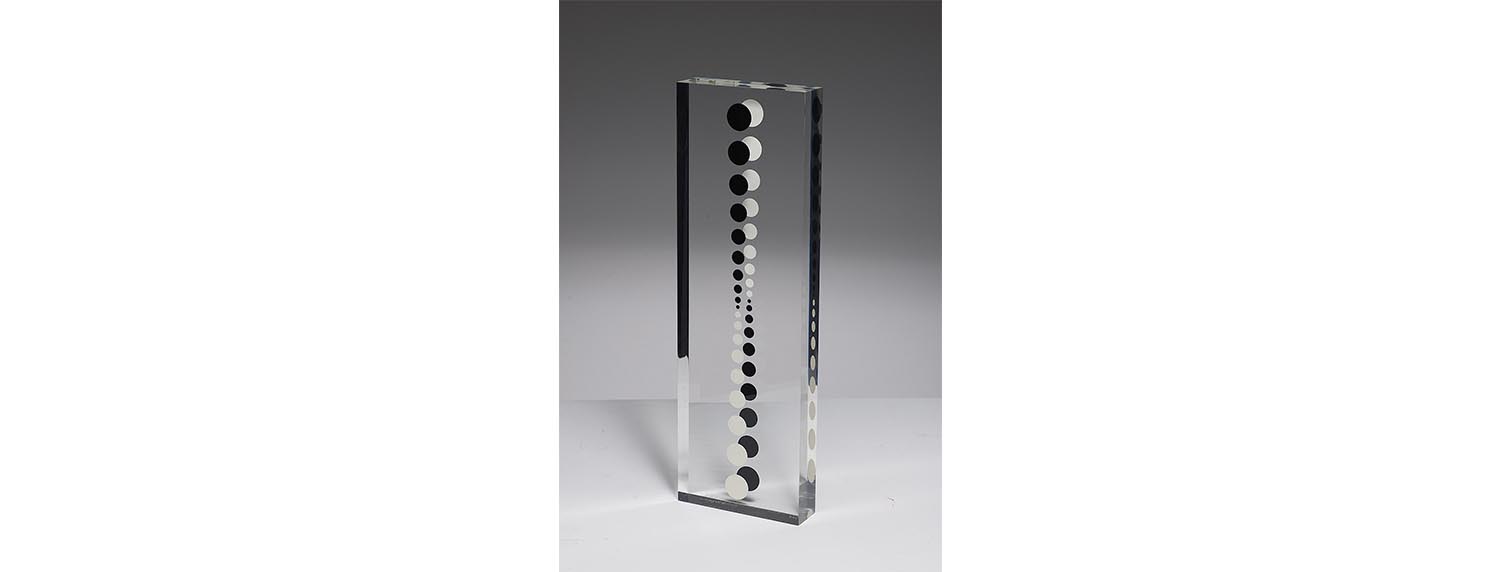The sculptor, engraver, illustrator and painter Sérvulo Esmeraldo dedicated himself at the beginning of his artistic career to woodcut. Since 1947, in Fortaleza, he attended Sociedade Cearense de Artes Plásticas – SCAP and interacted with Antonio Bandeira and Aldemir Martins. During this period, he took painting classes with Jean-Pierre Chabloz. In 1951, he met Marcelo Grassmann and Lívio Abramo. In 1956, he founded the Museu da Gravura (Engraving Museum), in his hometown, Crato, in Ceará. In 1957, he held an individual exposition at the Museum of Modern Art of São Paulo – MAM/SP and traveled to Europe with a scholarship by the French government. The first years in which he lived in France were for learning, initiation in the techniques of metal engraving and woodcut. He studied Lithography at the École Nationale Supérieure des Beaux-Arts and had access to the rare works of the Bibliothèque Nationale de France, which allowed him to study the engraving of Albrecht Dürer. These studies led him to create his own language, based on graphic arts. In 1959, under the direction of Johnny Friedlaender, he began his engraving work on metal. In the mid-1960s, he integrated the kinetic art movement, when he performed the Excitáveis works – paintings and objects moved by electrostatic electricity. He returned to Brazil in 1978, working on public art projects, including his monumental sculptures in the urban landscape of Fortaleza, a city where he has lived and worked since 1980. He was the founder and curator of Exposições Internacionais de Esculturas (International Exhibitions of Ephemeral Sculptures) (Fortaleza, Ceará, 1986 and 1991), and took part in several exhibitions, among them: 5th, 6th, 7th and 19th editions of International Biennial of São Paulo (1959, 1961, 1963, 1987); 14th Milan Triennial, 1967 – Italy; International Engraving Exhibition 1970 – Krakow, Poland; Panorama of Current Brazilian Art, at MAM – São Paulo, 1974, São Paulo; A Century of Sculpture in Brazil, at MASP, 1982 – São Paulo, São Paulo; Brazil +500 Years: Mostra do Conhecimento (Rediscovery Exhibition), at Fundação Bienal, 2000 – São Paulo, São Paulo. His work is represented in the main museums of the world and in other public and private collections of Brazil and abroad. Sérvulo Esmeraldo was born in Crato, Ceará, on February 27, 1929. He died in Fortaleza, Ceará, on February 1, 2017. He is one of the Brazilian artists of greater international projection, of intense geometric-constructive rigor and creative discipline.
When you began, you were dedicated to woodcut, figurative works. Then you go to abstraction, still with engraving, and now using metal. Can you describe this period, which goes from the late 1940s to the early 1960s, the period of beginnings, studies and research, both in Brazil and in Europe?
I often say that my work began with child’s play, but taking the toys seriously. I was lucky enough to be born in a very interesting region, marked by a particularly rich landscape and culture. The support from my parents was important in my choice. The “Sérvulo’s craftness”, as my “inventions” were called, were certainly the beginning of everything. The nature of the surroundings of Bebida Nova mill, in Crato, where I lived my childhood and part of my teen years, gave me enough material for different experiences, such as the small water wheels made of canes and which I put to work with water from “levadas” (small streams, common at the foot of the mountain range).
Obviously, drawing – which is where everyone starts – was always in my concerns, but I must admit that I preferred objects from the very beginning. I liked to sculpt three-dimensional landscapes using cajá caraca (bark from the trunk of the cajá tree). In this easy to cut material, he built landscapes rich in detail. Unfortunately, none of this remains. At one point, I had an interest in clay modeling. When I discovered Egypt, my interest turned to the construction of sarcophagi. My father mocked me, said that I was working for Egypt.
An important fact occurred when one day a publication from the English consulate arrived in our house, containing an article on engraving in the western hemisphere, emphasizing woodcut works by Oswaldo Goeldi. From my father, I learned that woodcut was the type of engraving used on the covers of the cordel booklets, present at the free fairs of Crato and Juazeiro do Norte. This was the beggining of a new world I came to investigate.
In 1949, I moved to Fortaleza. This change put me in contact with painters from SCAP – Sociedade Cearense de Artes Plásticas. We were doing camp workshops, on the weekends, in the outskirts of Fortaleza, on the beach, above all. This distinct association, in which the younger ones learned from their elders and vice versa, was a good learning experience. Together with the future designer Goebels Weyne and Zenon Barreto, we formed the young nucleus of the institution. Unlike the others, our interests went beyond painting and drawing.
At the beginning of 1951, I went to São Paulo, on the pretext of studying architecture, and decided to become a professional artist. After the Architecture course of FAU/USP, I seek an informal education – attending the artistic scene of São Paulo. Not by chance I went to work at Empresa Brasileira de Engenharia (Brazilian Engineering Company – EBE), where I almost became an engineer, if my call for art hadn’t been more eloquent. This period was extremely important to my knowledge in the area of ??natural sciences, and that helped me a lot at work. Until I was asked for a high position in the company. I replied to the emissary of the proposal that I could not accept, that I was going to be an artist. Shocked, the big man jumped in front of me, laughing, repeating, “He’s going to be an artist, he’s going to be an artist.”
I couldn’t be a full-time artist; in a short time I was at Correio Paulistano, acting as an illustrator, and sometimes as an art and culture reporter.
Since my arrival in São Paulo, I enthusiastically dedicated myself to woodcutting, exhibiting in 1956 at Clube dos Artistas, and in 1957 at the Museum of Modern Art of São Paulo. In this last one, the exposed works already were, to a large extent, geometric, constructive. A set of very cohesive engravings showed my interest in the triangle.
Going back a little further, you were born in Crato, Ceará, and, in your report, you said that “my references in plastic arts were paintings, or mediocre reproductions of paintings. And they were always figurative […] in the Public Library of Crato there was little about plastic arts.” How did your approach to visual arts come and, with it, the desire to become an artist?
As I said before, the landscape and culture of the place where I was born and raised helped a lot in my education. I always liked to watch, to pay attention to certain things framed by my interest. In the fairs of Crato and Juazeiro do Norte, besides the cordel booklets that attracted me to woodcutting, there were ceramics and, in the churches, the “ex-votos” – my first contact with the sculpture.
There were no art books in the master house, but there was good literature, scientific books, and encyclopedias. In the attic, where I installed my first atelier, we had a real treasure left by our uncles, who migrated to other centers to study and never returned.
Those old suitcases stayed there and no one touched it. As I chose the attic to work, I stayed there. Children would go out to play and I would go there, to make wooden objects, with no function, except playing. One day I had the idea of ??opening those suitcases and the treasure was revealed. That whole arsenal became a toy in our hands. We wore those old-fashioned clothes. My cousins ??mocked me for wearing those things seriously. There was a lot of books in Latin, French, interesting books. Thus began my love for the book, not only as a source of reading, but as an object. They had very beautiful prints. Sadly, all this has been lost – sold, given, destroyed.
I also learned a lot from the gypsies who visited us every year to repair pots and brass mills in the region. He watched their work from afar, learning the techniques, and then followed their tracks, picking up the chips left under the trees where they worked.
There was also a carpenter, Master Lucas, and in the city, a very competent neighbor goldsmith, with whom I learned something “from afar”, watching him through his window – Theopista Abath.
The beginning is figurative, then geometric, constructivist. This path, very simplistic on my part, covers aspects or stages of his work. Is it a summary of your work, or is it too reductive, just ramifications that your work, with information and training, spanned over 60 years of art? Describe how you view the path of your work to this day.
This passage from figurative to abstract was natural. I had in São Paulo a favorable environment for the development of my work. The effects of the 1st Bienal were alive. Decidedly, woodcut was my interest at that moment. My interest in details led me to abstraction. Not by chance, one day I found a piece of leaf in the street; observing its details, I saw the organization of its lines, the structure of its small triangles. This “finding” gave me the necessary opening. It was there, by observation. Driven by the same interest, as a boy in Crato, I came across a rope dragged by a horse and I saw that it was printing grooves in the mud. The need to show what I saw and wanted to emphasize has been with me all my life; I like to observe things that did not interest anyone. For example: I’ve always been a stone collector. In our region, there are many stones (calcareous), and I liked to see their design, shape, and color. Limestone is made by blades. I broke them, opened every blade, and there were very interesting designs between them. He liked to see and show people their beautiful abstract forms. My parents were the ones who cared the most. They were very perceptive.
I always had my ideas and opinions. There was a moment that although I already knew how to work the image with optical reliefs, I did not draw with volume – and although this type of drawing was hate by almost all the people to whom I showed it, I persisted. I liked to draw like this, without bothering to emphasize volumes, as I later found in folk art. I liked the accuracy of this type of drawing. Is there anything more real than a child’s drawing?
The description in the plan is a more accurate reading, details are more readable. A good example is the Egyptian image.
Looking back, I see that I have not changed anything. I have always been very objective, determined, consistent with my thinking regardless of the tastes and laws around me. A misunderstanding i had at Beaux Arts was precisely because I dared to mix techniques in the execution of a lithograph. The professor reacted with the justification that: “We, French, do not mix techniques”. I talked back: “I’m not French.”
Changes, influences, cultural exchanges, none of that affected my language. From the technical point of view, yes. But only in this regard.
In the 60s, your art enlarged engravings and drawings, moving on to other languages, through objects, reliefs and sculptures. The material was steel, acrylic. Can you describe this moment in your work? How was passing to three-dimensional works like?
I arrived in Paris in 1957 for the purpose of studying woodcutting at Beaux Arts in Adam’s studio. Unfortunately, the class was already full. The French government’s scholarship condition required me to study in an official course. I enrolled in Beaux Arts, in the lithography studio, a discipline that did not excite me. The next year I was in the free atelier of J. Friedlaender, of metal engraving. From the formal point of view, it was a fresh start. I, who already had a defined language in woodcut, had to put it aside. Engraving in metal is very different from engraving in wood, especially the burin. Unlike the protrusion we have in woodcut, in the burin we have those grooves that retain ink, and that passes to the paper by a pressing process. I have been fond of this technique, dedicating myself to it for many years. I built a history with metal engraving, with a considerable work in quality and quantity as well. I can say that in 1961, I had already found my language with this technique. At first, I was absorbed in engagements with galleries and publishers. But, I did not want to be a full time engraver. I had many ideas I didn’t use yet, objects with magnets and electromagnets, one of these was Escriba (Scribe). Kinetic art was gaining ground in Paris: Soto, Cruz-Diez, Takis, Buri, Tingely, Yacov Agam, among others, conquered their spaces.
In 1964, with the birth of Sabrina, my eldest daughter, we left the Quartier Latin, Rue Monsieur Le Prince, and went to live in Rosny sous Bois. Metal engraving was still my main occupation. As it turned out, there was a manufacturer of acrylic objects in the neighborhood, where there was a litter of scraps, leftovers, transparent acrylic or black and white opaque sheets. I started a series of small and medium sculptures with this material. Gluing plates to plates, I obtained blocks, which later were carved, according to their volumes.
Acrylic is a powerful electrical insulation and ends up being an important accumulator of dust. This annoying vocation reminded me of a joke from my child days. The plastic combs were magnetized by friction in the hair and chopped paper (this was our version of static electricity). In fact, what would be the first Excitable was never produced, it was modified. It was an alphabet – the 25 letters were repeated and we could have a poem randomly. My prototype did not interest anyone, and was considered disrespectful. The wooden box, which would be called “Máquina a Poetar”, is an interesting idea and I still think of using it.
With kinetic art, we have motion with volume, making it far from a static object. What made you come to this? Leaving two-dimensional in this way, a sculpture or object that asks for the viewer’s interaction? This interest in movement, in vibration? Some critics consider you to be a pioneer, or one of them, in kinetic art in Brazil. How did you come to this stage of formulating a thought for kinetic art and performing a work like O Escriba?
In 1967, I was invited to participate in the 1st Exposição Internacional do Livro-Objeto de Nice (International Exhibition of the Object-Book of Nice), organized by gallery owner Claude Givaudan. My idea was a book composed of three poems worked as objects. I chose the poems “Anunciação”, by Vinicius de Moraes; “L’Autonne Malade” by Apolinaire, and a third poem by Pablo Neruda. For the last two, I soon found the solution. Vinicius’s poem put me in trouble. I saw no way out for this “sensitive” poem, which begins as: “My virgin daughter / Where do you come from / With the earrings in the ear / Making “tlin-tlin” / And the crimson-colored skirt?”
The memory of a child’s play, in Crato, with the ebonite comb and shreded paper came to my mind. I glued a copy of the poem into the bottom of a small box and threw in chopped tissue paper over it and sealed the box with an acrylic top. When you rubbed your hand over the acrylic top, the shredded paper emerged and fell on the poem. Between 1967 and 1979, I made hundreds of these charming works, especially for its mystery. Regrettably, my return to Brazil also implied not to continue this work, due to the humidity of the air.
Another point that I consider very important in its trajectory is street art. It became visible to a wider view of spectators, and brings a relationship with space, monumentality. Anyway, what did it modify in your ideas and changed in the creation of your artistic process?
There was a group of Latin American artists in Paris who did not cross their arms during the military regime in their countries. I was one of them. We started to be frowned upon by the regime. This imposed a long absence from Brazil after 1967, our last vacation here. With the first winds of political openness and an agenda of exhibitions, I disembarked at Recife airport in 1975. My exhibits were well received and some orders arrived. The next year, I was back, with new exhibits and more designs. It was on the way back from this trip, when I took a flight to Paris, from Rio de Janeiro, in a beautiful sunset, when I saw the exuberant light from above, I decided I should not waste it anymore. My travels became smaller, and my stays became longer. Public art, especially sculpture, was the vector of this change. My wish was to endorse an open-air museum.
Following the question above, on your return to Ceará, I think that in 1977, you made your work a bridge to architecture. As soon as it leaves the buildings, it takes over the city, interacting with the people and the space; the street art, which we speak above. This thought and action, but no longer static work, brings together an interaction with the population. Is this the result of your experience, your desire or a political idea so that art belongs to everyone? Or at least, seen by all?
In 1977, I still lived in France. It was in 1979 that I came and I never came back. I worked hard to transform Fortaleza into a city benefited by plastic arts. In that sense, I worked hard, negotiating with politicians, architects, builders, businessmen. We were able to create a law for the inclusion of works of art in public works, in the Organic Law of Fortaleza, from the early 1990s, which was never regulated. The International Exposition of Ephemeral Sculptures was an effort to move this idea. My work is on the street, it is poorly preserved, but it’s there – it’s a resistance!
Lines, angles, shadows, graphics, interactions and recreations of works by the spectator, movement with volume, no longer static object or sculpture are words I read about his work. They are opinions, considerations. Your artistic work, considered geometric and constructive, is recognized internationally. Does your fulfillment as a work in itself and as a set of works fulfill the desire of the child of Crato who one day wanted to be an artist, or is something always missing in obtaining this desire?
I had no desire to be an artist because I did not even know what it meant to be an artist. I want to keep working.
You are an artist from Ceará, living in your home state today. How do you see Northeast art in the Northeast region today, and your relation to the national and international artistic process?
There is a historical gap. In the case of Ceará, art courses are few and too recent. There are museums that are committed to the history of art and to contemporaneity. The absence of critical practice in the local media is another negative factor. We have one or two galleries for a capital with more than two and a half million citizens. There are few rare collectors. There is a state of inertia and generations of artists wanting to work. We must break this inertia. I imagine that states like Pernambuco and Bahia have a better situation, since they are more equipped and have a certain tradition. Northeast plays an important role in Brazilian culture, and its contribution to the country’s history of art was not small. There should be incentive policies for the creation and maintenance of museums in the region, extending to cultural centers, galleries, etc.
It is true that in recent years there has been an advance in the field of culture, with the arrival of cultural centers, incentive laws, edicts. There is a movement in Southeast Brazil with reflexes here. But the gap still exists.
I am happy with my choice to live in Ceará. There are several reasons. They are so many that mentioning that sun, that light is enough.
To wrap it up, in yourtrajectory, we had in 1956 the creation of the Museum of Engraving in Crato. In another moment, we see it holding the International Exhibition of Ephemeral Sculptures in Fortaleza. In the middle of it, street art. Does the purpose of the artist go beyond the fulfillment of his art alone? Is performance within the community essential to the existence of the work of art? Or is this action, which you took, a particular fact of each artist? As an extension of the question, how do you see art today.
The artist Sérvulo Esmeraldo is a politically engaged citizen.


